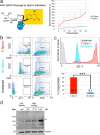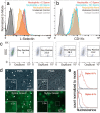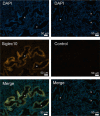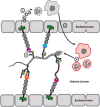The female reproductive tract contains multiple innate sialic acid-binding immunoglobulin-like lectins (Siglecs) that facilitate sperm survival
- PMID: 31201275
- PMCID: PMC6682739
- DOI: 10.1074/jbc.RA119.008729
The female reproductive tract contains multiple innate sialic acid-binding immunoglobulin-like lectins (Siglecs) that facilitate sperm survival
Abstract
A sperm that fertilizes an egg has successfully survived multiple checkpoints within the female reproductive tract, termed pre-fertilization events. The leukocytic response is a pre-fertilization event in which sperm trigger an immune response that promotes homing of circulating leukocytes to the uterine lumen to destroy most sperm. Various glycoconjugates decorate the sperm surface, including sialic acids, which are abundant at the sperm surface where they cap most glycan chains and regulate sperm migration through cervical mucus, formation of the sperm oviductal reservoir, and sperm capacitation. However, the role of sperm-associated sialic acids in the leukocytic reaction remains unknown. The cognate endogenous binding partners of sialic acids, sialic acid-binding immunoglobulin-like lectins (Siglecs) play a pivotal role in regulating many immune responses. Here we investigated whether sperm-associated sialic acids inhibit activation of neutrophils, one of the major immune cells involved in the leukocytic reaction. We used in vitro interactions between sperm and neutrophils as well as binding assays between sperm and recombinant Siglec-Fc chimeric proteins to measure interactions. Moreover, we examined whether Siglecs are expressed on human and mouse endometria, which have a role in initiating the leukocytic reaction. Surprisingly less sialylated, capacitated, sperm did not increase neutrophil activation in vitro However, we observed expression of several Siglecs on the endometrium and that these receptors interact with sialylated sperm. Our results indicate that sperm sialic acids may interact with endometrial Siglecs and that these interactions facilitate sperm survival in the face of female immunity.
Keywords: glycan; innate immunity; lectin; reproduction; sialic acid; sialic acid-binding immunoglobulin-like lectins (Siglec); spermatozoa.
© 2019 Tecle et al.
Conflict of interest statement
The authors declare that they have no conflicts of interest with the contents of this article
Figures








Similar articles
-
Sialylated Cervical Mucins Inhibit the Activation of Neutrophils to Form Neutrophil Extracellular Traps in Bovine in vitro Model.Front Immunol. 2019 Nov 6;10:2478. doi: 10.3389/fimmu.2019.02478. eCollection 2019. Front Immunol. 2019. PMID: 31781090 Free PMC article.
-
Siglecs: A journey through the evolution of sialic acid-binding immunoglobulin-type lectins.Dev Comp Immunol. 2018 Sep;86:219-231. doi: 10.1016/j.dci.2018.05.008. Epub 2018 May 8. Dev Comp Immunol. 2018. PMID: 29751010 Review.
-
Discovery and expression of 3 siglecs-like in Oreochromis niloticus neutrophil, and their interaction with group B streptococcal sialylated capsular polysaccharides.Mol Immunol. 2016 May;73:158-69. doi: 10.1016/j.molimm.2016.01.005. Epub 2016 Feb 1. Mol Immunol. 2016. PMID: 26847490
-
Host and pathogen hyaluronan signal through human siglec-9 to suppress neutrophil activation.J Mol Med (Berl). 2016 Feb;94(2):219-33. doi: 10.1007/s00109-015-1341-8. Epub 2015 Sep 28. J Mol Med (Berl). 2016. PMID: 26411873 Free PMC article.
-
Discovery, classification, evolution and diversity of Siglecs.Mol Aspects Med. 2023 Apr;90:101117. doi: 10.1016/j.mam.2022.101117. Epub 2022 Aug 18. Mol Aspects Med. 2023. PMID: 35989204 Free PMC article. Review.
Cited by
-
CD33 as a leukocyte-associated marker expressed on human spermatozoa.BMC Res Notes. 2023 Apr 20;16(1):57. doi: 10.1186/s13104-023-06324-z. BMC Res Notes. 2023. PMID: 37081561 Free PMC article.
-
Big-Data Glycomics: Tools to Connect Glycan Biosynthesis to Extracellular Communication.Trends Biochem Sci. 2021 Apr;46(4):284-300. doi: 10.1016/j.tibs.2020.10.004. Epub 2020 Dec 18. Trends Biochem Sci. 2021. PMID: 33349503 Free PMC article. Review.
-
Lactobacillus crispatus S-layer proteins modulate innate immune response and inflammation in the lower female reproductive tract.Nat Commun. 2024 Dec 30;15(1):10879. doi: 10.1038/s41467-024-55233-7. Nat Commun. 2024. PMID: 39737998 Free PMC article.
-
Siglecs in Brain Function and Neurological Disorders.Cells. 2019 Sep 22;8(10):1125. doi: 10.3390/cells8101125. Cells. 2019. PMID: 31546700 Free PMC article. Review.
-
Ligand Recognition by the Macrophage Galactose-Type C-Type Lectin: Self or Non-Self?-A Way to Trick the Host's Immune System.Int J Mol Sci. 2023 Dec 3;24(23):17078. doi: 10.3390/ijms242317078. Int J Mol Sci. 2023. PMID: 38069400 Free PMC article. Review.
References
Publication types
MeSH terms
Substances
Grants and funding
LinkOut - more resources
Full Text Sources
Other Literature Sources
Miscellaneous

